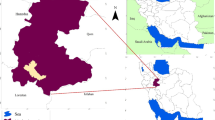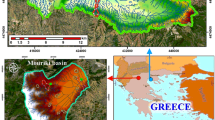Abstract
Conjunctive use of water is an integral part of water resources management. Future groundwater scenarios will dictate the water management policies. The present research focuses on future groundwater scenario generation based on regional scale CMIP5 data. The future scenarios for the years 2030, 2050 and 2080 were generated in terms of the groundwater potential zones (GWPZs) with seven futuristic parameters [land use and land cover, maximum temperature, minimum temperature, rainfall, groundwater recharge, groundwater table and evapotranspiration (ET)]. The Dyna-CLUE and MIROC5 were used for generation of the future change in climate and land use/land cover scenarios. The Soil and Water Assessment Tool (SWAT) was utilized for the recharge and ET estimation. Future groundwater heads were calculated by using the Modular Three-Dimensional Finite-Difference Groundwater Flow (MODFLOW). Bias corrected rainfall and temperature data of Representative Concentration Pathways (RCP 4.5) were utilized. Total twelve water quality parameters (pH, Cl−, Mg2+, F−, Na+, EC, TH, HCO3−, K+, Ca2+, SO42− and PO42−) were used for groundwater quality zone (GWQZ) mapping. These GWPZ and GWQZ were divided into three (poor potential, moderate potential, and good potential) and four zones (good quality, moderate quality, poor quality and above permissible limit) respectively. The lower part of the basin was identified as poor GWPZ (35.76% for 2030) and GWQZ due to an increase in urban areas. However, the middle and upstream portion covers good, moderate zones. Field-based soil moisture and groundwater level monitoring data were utilized for validation purposes. It was observed that groundwater level < 5 m bgl corresponds to good GWPZ. It was also observed that recharge and pH were the crucial parameters for good GWPZ (+11.83%) and GWQZ (−21.31%) according to sensitivity analysis.







Similar content being viewed by others
References
Achu AL, Thomas J, Reghunath R (2020) Multi-criteria decision analysis for delineation of groundwater potential zones in a tropical river basin using remote sensing, GIS and analytical hierarchy process (AHP). Groundw Sustain Dev, 100365
Alonso J, Lamata T (2006) Consistency in the analytic hierarchy process: a new approach. Int J Uncertainty Fuzziness Knowledge Based Syst 14(4):445–459
Amineh ZBA, Hashemian SJAD, Magholi A (2017) Integrating Spatial Multi Criteria Decision Making (SMCDM) with Geographic Information Systems (GIS) for delineation of the most suitable areas for aquifer storage and recovery (ASR). J of hydro 551:577–595.
Bathrellos GD, Gaki-Papanastassiou K, Skilodimou HD, Papanastassiou D, Chousianitis KG (2012) Potential suitability for urban planning and industry development using natural hazard maps and geological–geomorphological parameters. Environ Earth Sci 66(2):537–548
Bathrellos GD, Skilodimou HD, Chousianitis K, Youssef AM, Pradhan B (2017) Suitability estimation for urban development using multi-hazard assessment map. Sci Total Environ 575:119–134
Chen W, Li H, Hou E, Wang S, Wang G, Panahi M, Xiao L (2018) GIS-based groundwater potential analysis using novel ensemble weights-of-evidence with logistic regression and functional tree models. Sci Total Environ 634:853–867
Das B, Pal SC (2019) Combination of GIS and fuzzy-AHP for delineating groundwater recharge potential zones in the critical Goghat-II block of West Bengal, India. HydroResearch 2:21–30
De Andreis S, Ricci PE (2005) Modelling population growth vialaguerre-type exponentials. Math Comput Model 42(13):1421–1428
Dhanasekarapandian M, Chandran S, Devi DS, Kumar V (2016) Spatial and temporal variation of groundwater quality and its suitability for irrigation and drinking purpose using GIS and WQI in an urban fringe. J Afr Earth Sci 124:270–288
Dhar A, Sahoo S, Sahoo M (2015) Identification of groundwater potential zones considering water quality aspect. Environ Earth Sci 74(7):5663–5675
Fang GH, Yang J, Chen YN, Zammit C (2015) Comparing bias correction methods in downscaling meteorological variables for a hydrologic impact study in an arid area in China. Hydrol Earth Syst Sci 19(6):2547–2559
Freeze RA, Cherry JA (1979) Groundwater, 604 pp.
Fukunaga DC, Cecilio RA, Zanetti SS, Oliveira LT, Caiado MAC (2015) Application of the SWAT hydrologic model to a tropical watershed at Brazil. Catena 125:206–213
Guzman JA, Moriasi DN, Gowda PH, Steiner JL, Starks PJ, Arnold JG, Srinivasan R (2015) A model integration framework for linking SWAT and MODFLOW. Environ Modelling & Software, 73:103–116.
Harbaugh A W (2005) MODFLOW-2005, the US geological survey modular ground-water model: the ground-water flow process (p. 253). Reston, VA: US Department of the Interior, US Geol Surv
Jasrotia AS, Ajay KT, Upasna A, Baghwan DB (2018) Geoinformatics based groundwater quality assessment for domestic and irrigation uses of the Western Doon valley, Uttarakhand, India. Groundw for Sustain Dev 6:200–212
Kim KH, Cho J, Lee YH, Lee WS (2015) Predicting potential epidemics of rice leaf blast and sheath blight in South Korea under the RCP 4.5 and RCP 8.5 climate change scenarios using a rice disease epidemiology model, EPIRICE. Agric For Meteorol 203:191–207
Kumar A, Pandey AC (2016) Geoinformatics based groundwater potential assessment in hard rock terrain of Ranchi urban environment, Jharkhand state (India) using MCDM–AHP techniques. Groundw Sustain Dev 2:27–41
Kwon TS, Lee CM (2015) Prediction of abundance of ants according to climate change scenarios RCP 4.5 and 8.5 in South Korea. J Asia Pac Biodiv 8(1):49–65
Maheswaran R, Khosa R, Gosain AK, LahariS SSK, Chahar BR, Dhanya CT (2016) Regional scale groundwater modelling study for Ganga River basin. J Hydrol 541:727–741
Mahmoud HH, Kotb ADM (2017) Impact of the geological structures on the groundwater potential using geophysical techniques in west BaniMazar area, El Minia–Western Desert, Egypt. J Afr Earth Sci 130:161–173
Mechal A, Wagner T, Birk S (2015) Recharge variability and sensitivity to climate: the example of GidaboRiver Basin, Main Ethiopian rift. J Hydrol Reg Stud 4:644–660
Mogaji KA, San Lim H (2018) Application of Dempster-Shafer theory of evidence model to geoelectric and hydraulic parameters for groundwater potential zonation. NRIAG J Astron Geophys,
Naghibi SA, Moghaddam DD, Kalantar B, Pradhan B, Kisi O (2017) A comparative assessment of GIS-based data mining models and a novel ensemble model in groundwater well potential mapping. J Hydrol 548:471–483
Nampak H, Pradhan B, Manap MA (2014) Application of GIS based data driven evidential belief function model to predict groundwater potential zonation. J Hydrol 513:283–300
Panagopoulos GP, Bathrellos GD, Skilodimou HD, Martsouka FA (2012) Mapping urban water demands using multi-criteria analysis and GIS. Water Resour Manag 26(5):1347–1363
Prasad YS, Rao BV (2018) Groundwater depletion and groundwater balance studies of KandivalasaRiverSubBasin, Vizianagaram District, Andhra Pradesh, India. Groundw Sustain Dev 6:71–78
Rahmati O, Pourghasemi HR, Melesse AM (2016) Application of GIS-based data driven random forest and maximum entropy models for groundwater potential mapping: a case study at Mehran region, Iran. Catena 137:360–372
Raju KS, Sonali P, Kumar DN (2017) Ranking of CMIP5-based global climate models for India using compromise programming. Theor Appl Climatol 128(3–4):563–574
Saaty TL (1980) The analytic hierarchy process: planning, priority setting, resource allocation. McGraw-Hill, New York
Sahoo S, Sil I, Dhar A, Debsarkar A (2018) Das P Kar a (2018) future scenarios of land-use suitability modeling for agricultural sustainability in a river basin. J Clean Prod 205:313–328
Sahoo S, Dey S, Dhar A, Debsarkar A, Pradhan B (2019a) On projected hydrological scenarios under the influence of bias-corrected climatic variables and LULC. Ecol Indic 106:105440
Sahoo S, Dhar A, Debsarkar A, Kar A (2019b) Future scenarios of environmental vulnerability mapping using grey analytic hierarchy process. Nat Resour Res 28(4):1461–1483
Sakai N, Mohamad ZF, Nasaruddin A, Kadir SNA, Salleh MSAM, Sulaiman AH (2018) Eco-heart index as a tool for community-based water quality monitoring and assessment. Ecol Indic 91:38–46
Velasco V, Tubau I, Vázquez-Suñè E, Gogu R, Gaitanaru D, Alcaraz M, Sanchez-Vila X (2014) GIS-based hydrogeochemical analysis tools (QUIMET). Comput Geosci 70:164–180
Verburg PH, Soepboer W, Veldkamp A, Limpiada R, Espaldon V, Mastura SS (2002) Modeling the spatial dynamics of regional land use: the CLUE-S model. Environ Manag 30(3):391–405
Wei X, Bailey RT, Records RM, Wible TC, Arabi M (2018) Comprehensive simulation of nitrate transport in coupled surface-subsurface hydrologic systems using the linked SWAT-MODFLOW-RT3D model. Environ Model Softw
Zahedi S (2017) Modification of expected conflicts between drinking water quality index and irrigation water quality index in water quality ranking of shared extraction wells using multi criteria decision making techniques. Ecol Indic 83:368–379
Zaidi FK, Nazzal Y, Ahmed I, Naeem M, Jafri MK (2015) Identification of potential artificial groundwater recharge zones in northwestern Saudi Arabia using GIS and Boolean logic. J Afr Earth Sci 111:156–169
Author information
Authors and Affiliations
Corresponding author
Ethics declarations
Conflict of Interest
No conflict of interest.
Additional information
Publisher’s Note
Springer Nature remains neutral with regard to jurisdictional claims in published maps and institutional affiliations.
Rights and permissions
About this article
Cite this article
Sahoo, S., Dhar, A., Debsarkar, A. et al. Can Groundwater Scenarios Be Predicted from Future Regional Climatic Input Variables?. Water Resour Manage 34, 4815–4830 (2020). https://doi.org/10.1007/s11269-020-02692-4
Received:
Accepted:
Published:
Issue Date:
DOI: https://doi.org/10.1007/s11269-020-02692-4




